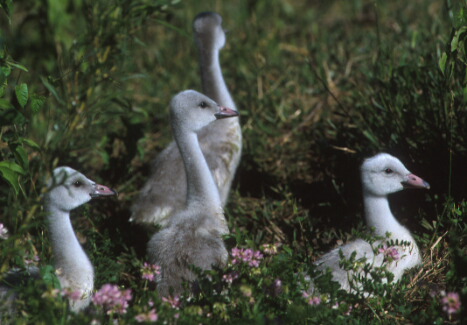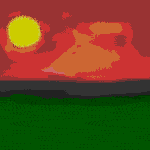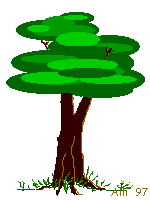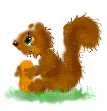|
 What
is the largest flying bird in North America? Why the trumpeter swan, of
course!! The trumpeter swan has a wing span of 7.5 - 8 feet (228 - 244
cm) and can weigh up to 35 pounds (13.6 kg.) These beautiful and graceful
pure white birds have ebony black bills, legs, and feet. They are a sight
that few of us get to see in our lifetimes. They earned their name due
to their distinctive "trumpet-like" sound, caused by a loop
in their larynx. What
is the largest flying bird in North America? Why the trumpeter swan, of
course!! The trumpeter swan has a wing span of 7.5 - 8 feet (228 - 244
cm) and can weigh up to 35 pounds (13.6 kg.) These beautiful and graceful
pure white birds have ebony black bills, legs, and feet. They are a sight
that few of us get to see in our lifetimes. They earned their name due
to their distinctive "trumpet-like" sound, caused by a loop
in their larynx.
Once
found throughout North America, these swans now spend their winters in
British Columbia, Washington, Northern Oregon, and a few other areas.
Flying north in the springtime, trumpeter swans find lakes, rivers, and
estuaries in Alaska, Minnesota, Wisconsin, north British Columbia, Alberta,
and southern Yukon. A pair of swans (males are called cobs and females
are pens) will mate for life, and each spring, make a nest near a lake
or in a marsh. The female trumpeter swan lays 5 - 8 eggs. These eggs incubate
for around a month, producing a brood of 2 - 4. The juvenile swans, cygnets,
follow their parents south in the fall.
The
trumpeter swan is a modern-day success story. These majestic birds were
hunted for their skins, feathers, and meat while others found their natural
wet habitat changed. By the 1920's, trumpeter swans were in serious trouble
and were close to vanishing from the earth. Passage of laws protecting
them as well as other programs have brought the trumpeter swan from the
brink of extinction to around 16,000.
What
are these programs responsible for the return of this swan? One very
interesting program involves the Wisconsin Department of Natural Resources.
Eggs are removed from Alaskan nests, incubated and hatched in a zoo, then
the cygnets were raised in one of two ways:
For
two years the cygnets are raised on a pond with their flight feathers
trimmed to keep them from flying. They are then relocated to northern
Wisconsin. It is only normal for some of these swans to become used to
humans. In fact, there is a true story
of a trumpeter swan who loved peanut butter sandwiches!!
 The
other group are flown to northern Wisconsin soon after hatching. Separated
into groups, they are cared for by university interns who sit inside floating
blinds that had a floating adult swan decoy attached. The intern "mom"
shows the cygnets where and what to eat, how to act as swans, and to fear
predators without the swans learning to trust humans. Alas, no peanut
butter sandwiches but more safety for the swans. The
other group are flown to northern Wisconsin soon after hatching. Separated
into groups, they are cared for by university interns who sit inside floating
blinds that had a floating adult swan decoy attached. The intern "mom"
shows the cygnets where and what to eat, how to act as swans, and to fear
predators without the swans learning to trust humans. Alas, no peanut
butter sandwiches but more safety for the swans.
The
Wisconsin programs now have 100 swans living in the wild. Other states
and Canada are also reintroducing swans.
Other
programs throughout North America help manage the adult trumpeter swans.
Since swans eat grass as do cows, programs help farmers and wildlife agencies
work together for the betterment of all. Ten adult swans will eat as much
as one cow. For areas with growing swan populations, this can mean the
farmers are having to feed the equivalent of 200 extra cows without receiving
any monetary benefit. As well as eating the grass, hungry trumpeter swans
can over graze fields, compact the soil and make huge depressions in muddy
fields. All of this can add up to lose of precious feed for the farmers'
cows as well as a big expense. The swan management programs, such as the
one in the Comox Valley of British Columbia, have developed workable solutions
to these problems.
There
are, of course, still problems for the trumpeter swans. Some hunters mistake
these protected birds for snow geese. Other swans eat lead shot from the
bottom of lakes. [Although lead shot illegal now, the lead shot from years
past still remains at the bottom of lakes and in marshes where the swans
eat.] But the trumpeter swan populations are increasing, due to programs
like the ones above and public concern. If all goes well, our children
and their children will thrill to the sight of one of these magnificent
creatures or hear their call to their mates in the foggy and misty mornings.
Swan
Identification
There are three species of swans in North America.
The Trumpeter Swan (Cygnus buccinator) and Tundra Swan (C. columbianus)
are indigenous, while the Mute Swan (Cygnus olor) is a Eurasian species
that has been introduced and now breeds in the wild in some areas. All
three are very large all-white birds.
http://www.trumpeterswansociety.org/id.htm
|

 First,
Creator put the Lands out in the vast Ocean. These Lands were made
of Rocks and Sands, which are the oldest things upon this Earth.
With both the North and South American continents, the Oceans were
divided. That is why there is a number of different Oceans surrounding
them. Now, these Lands were barren. Creator looked upon them and
was not happy. They looked too much alike to suit Him, so He created
Mountains and Streams. Some Lands were made to be much higher than
others were. Some were meant to be Deserts, and some were meant
to be near the Oceans. And some Lands were meant to be very cold.
Now, Creator was happy.
First,
Creator put the Lands out in the vast Ocean. These Lands were made
of Rocks and Sands, which are the oldest things upon this Earth.
With both the North and South American continents, the Oceans were
divided. That is why there is a number of different Oceans surrounding
them. Now, these Lands were barren. Creator looked upon them and
was not happy. They looked too much alike to suit Him, so He created
Mountains and Streams. Some Lands were made to be much higher than
others were. Some were meant to be Deserts, and some were meant
to be near the Oceans. And some Lands were meant to be very cold.
Now, Creator was happy. Second,
He made the great Forests and the Plains. He let these things grow
and mature, and let them learn how to exist in relation to the Rivers
and Streams. He sent rains upon these things, so that they might
grow and be nourished. The thunder and lightning were signs of His
power and might. He allowed the plants to make air, clean and pure.
Creator put great beauty in these creations, such as flowers and
many-colored leaves. He allowed these Trees to bear seeds, nuts,
berries, and shade for future uses. To every Tree and plant that
He put here, there was a purpose assigned. Creator looked upon this
and He saw that it was good.
Second,
He made the great Forests and the Plains. He let these things grow
and mature, and let them learn how to exist in relation to the Rivers
and Streams. He sent rains upon these things, so that they might
grow and be nourished. The thunder and lightning were signs of His
power and might. He allowed the plants to make air, clean and pure.
Creator put great beauty in these creations, such as flowers and
many-colored leaves. He allowed these Trees to bear seeds, nuts,
berries, and shade for future uses. To every Tree and plant that
He put here, there was a purpose assigned. Creator looked upon this
and He saw that it was good. Third,
Creator placed the many varieties of Birds and Animals upon this
Land. They all learned how to find food and shelter, and they all
had a wonderful harmony among them. To each creature that He made,
He assigned a purpose. The Creator looked upon these things and
He saw that it was good. As Creator looked upon the vast beauty
of the Lands, the Trees, the Animals, the Birds, and the Waters,
He smiled. He thought, "I must put Man here to enjoy all of
My great creations. I will put him here, and give him the purpose
of Keeper of all of my great creations."
Third,
Creator placed the many varieties of Birds and Animals upon this
Land. They all learned how to find food and shelter, and they all
had a wonderful harmony among them. To each creature that He made,
He assigned a purpose. The Creator looked upon these things and
He saw that it was good. As Creator looked upon the vast beauty
of the Lands, the Trees, the Animals, the Birds, and the Waters,
He smiled. He thought, "I must put Man here to enjoy all of
My great creations. I will put him here, and give him the purpose
of Keeper of all of my great creations." The
Creator did not call these people Native Americans or Indians. He
called them Human Beings--People. These people were created in the
image of our great Creator. Creator was very pleased with these
native peoples. They used His creations with care and honor. Human
nature being what it was, the different tribes sometimes fought
over territories, but there was great peace across the Land as a
whole. Although they spoke many different languages and dialects,
they could all communicate with each other. The Creator looked down
upon this and He saw that it was very good. He smiled upon all of
His Creations.
The
Creator did not call these people Native Americans or Indians. He
called them Human Beings--People. These people were created in the
image of our great Creator. Creator was very pleased with these
native peoples. They used His creations with care and honor. Human
nature being what it was, the different tribes sometimes fought
over territories, but there was great peace across the Land as a
whole. Although they spoke many different languages and dialects,
they could all communicate with each other. The Creator looked down
upon this and He saw that it was very good. He smiled upon all of
His Creations. What
is the largest flying bird in North America? Why the trumpeter swan, of
course!! The trumpeter swan has a wing span of 7.5 - 8 feet (228 - 244
cm) and can weigh up to 35 pounds (13.6 kg.) These beautiful and graceful
pure white birds have ebony black bills, legs, and feet. They are a sight
that few of us get to see in our lifetimes. They earned their name due
to their distinctive "trumpet-like" sound, caused by a loop
in their larynx.
What
is the largest flying bird in North America? Why the trumpeter swan, of
course!! The trumpeter swan has a wing span of 7.5 - 8 feet (228 - 244
cm) and can weigh up to 35 pounds (13.6 kg.) These beautiful and graceful
pure white birds have ebony black bills, legs, and feet. They are a sight
that few of us get to see in our lifetimes. They earned their name due
to their distinctive "trumpet-like" sound, caused by a loop
in their larynx. The
other group are flown to northern Wisconsin soon after hatching. Separated
into groups, they are cared for by university interns who sit inside floating
blinds that had a floating adult swan decoy attached. The intern "mom"
shows the cygnets where and what to eat, how to act as swans, and to fear
predators without the swans learning to trust humans. Alas, no peanut
butter sandwiches but more safety for the swans.
The
other group are flown to northern Wisconsin soon after hatching. Separated
into groups, they are cared for by university interns who sit inside floating
blinds that had a floating adult swan decoy attached. The intern "mom"
shows the cygnets where and what to eat, how to act as swans, and to fear
predators without the swans learning to trust humans. Alas, no peanut
butter sandwiches but more safety for the swans.